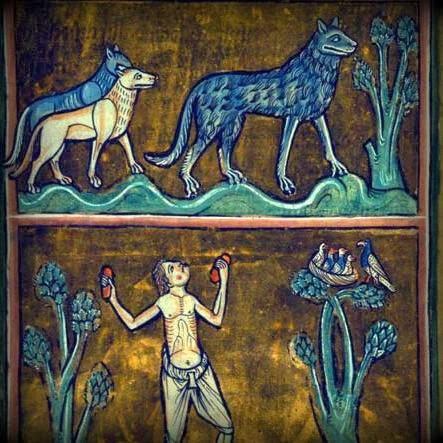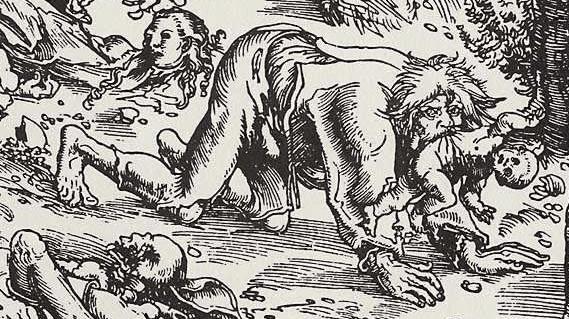A Brief History Of Europe's Werewolf Trials

Werewolves, or lycanthropes, if you're feeling fancy, have been around as a myth since ancient times, but there was a period in Europe when they were taken a whole lot more seriously. Not only were they believed to be real, the suspected werewolves were subjected to trial in the same way as the accused witches of Salem. Let's take a look at the mass frenzy surrounding werewolves, the strange (and sometimes sexist?) connection between their trials and the witch trials of the same period, and the oh-so-wonderful link between drugs and insanity.

At the time, different social classes had very different opinions about the meaning of "werewolf". Farmers, still steeped in the region's pagan mythology, blamed werewolves for dead animals or interpersonal disputes and sought to bring the perpetrators to justice. If it wasn't bad enough for humans to accuse each other of being actual animals, many of the accused were mentally ill or (in Salem) poor and isolated from most of the population. In true witch trial tradition, confessions often come only after long bouts of "questioning" that certainly involve torture.

The Church's official stance on this in the late 1400s was essentially "werewolves are as bad as they are pagan." By the time werewolf/witch hunting was in full swing in the late 1500s and early 1600s, the Church had changed its stance to something more like "werewolfs are bad because they are in league with the devil." In fact, many werewolves who were sentenced were sentenced to death for witchcraft, not for the crime of being a werewolf. Theis of Kaltenbrunn, or "Livonian werewolf", admits to becoming a werewolf, but only to go to hell to fight for humanity in wolf form as God's self-described hunter. He refused to accept that he was in alliance with Satan, so he descended from the light---with a whip. You know things are bad when it comes to kindness.

Perhaps people with less colorful imagination didn't get carried away so easily. One of the earliest reported werewolves was in 1521 in Poligny, France, when a traveler was attacked by a wolf, tracked down, and found to have Michel Verdun dripping with blood. For some reason, Verdun not only confessed to being a werewolf but also named Pierre Bourget and Philibert Montot as fellow wolves. His stories were suspiciously inconsistent with how, exactly, one becomes a werewolf; Verdun states that he was given power by a man in black, while Bourget states that Verdun had given him a healer and forced him to forsake his baptism. (Montot didn't say anything about it, but he was executed anyway.)
In 1651, Estonian werewolf trials turned up an 18-year-old one, known simply as Hans. He said he was a werewolf for two years, bitten by, you guessed it, a man in black. Noting that this was Europe in the 1600s, the court decided that he could only become a werewolf through a satanic pact, making him a witchcraft and therefore sentenced to death.

Some werewolves were linked to actual crimes. Jacques Roulette (Werewolf of Angers/Cod, depending on which city you choose to name) was found wounded and half-naked near the mutilated corpse of a teenage boy. Also seen on the spot? Wolves. Apart from these circumstances no other evidence was needed, he was arrested. Unlike other well-known "werewolves", Roulette quickly confessed and even ordained, claiming that he had previously killed and ate others. Oddly enough, Roulette was deemed mentally incompetent and sentenced to an insane asylum and religious education instead of execution.
In 1572, after the bodies of several missing children were found unscathed in the woods of Dole, France (probably unrelated to the fruit company), the group responsible for finding the culprit noticed that they were hunting one of the wolves. Looked like your neighbor. They took him and ran with him, quickly accusing the local peculiar Gilles Garnier and his wife. The couple were thrown under the bus and tortured on the rack by more than 50 witnesses, who successfully falsified a confession from Garnier. Less than a year later, he was burned at the stake.

The most infamous werewolf of the time was Peter Stubbey, a.k.a. Werewolf of Bedberg. In 1589, pamphlets warning about his ability to change shape began circulating in London, describing him with "the sharpest and ferocious teeth, a massive body and powerful claws". Stubbey's werewolf transformation reportedly came from a magical waistband that he tied around his waist, so they were clearly getting bored with the same old "treaty with the devil".
Stubbey was accused of killing and eating his victims for more than 25 years, and he also confessed to incest with his daughter and cannibalizing his own son, just to spice things up. As penance for these crimes, she was tied to a wheel before her skin was peeled off with hot poker, her arms and legs were broken, her head was cut off, and her body was burned. was. Not satisfied with this, he installed the body of a wolf with Stubb's head in the town square as a warning to anyone else interested in becoming a werewolf. They didn't do the work in half, that's the point. In medieval Europe, wolves were the most dangerous predators around, and they often snuck on gibbets next to their human counterparts.

No comments: